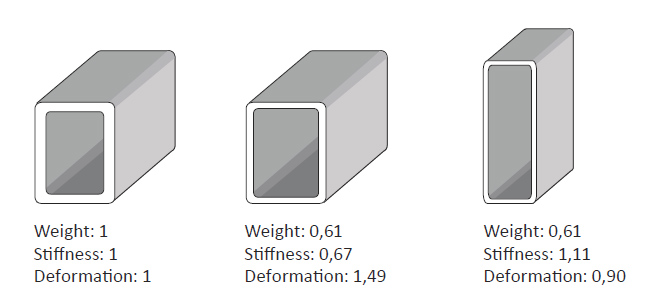Articles
Innovative design with high-strength steel
October 09, 2015 0:00 CEST 6 min read
Design challenges and rewards
Thousands of different steel grades with many different properties are available on the market today. However, all carbon steels are equal when it comes to two properties. They all have the same density (7,800 kg/m3 or 0.28 lb/in3) and Young’s modulus.Young’s modulus is a mechanical property that describes the elastic response to an applied force. For steel, this value is set to 200 GPa (29,000,000 psi).
The specific weight and Young’s modulus are natural constants for steel that designers must always consider.
When we want our products to be stronger, lighter or more efficient, our primary options are:
- Upgrade to a steel with a higher yield and tensile strength, such as Strenx®.
- Use less material in the product in order to save weight.
- Optimize the design to suit the purpose of the product upgrade.
So, how much weight can you cut by upgrading to Strenx® high-strength steel and optimizing the design? Depending on the scenario, you can gain a potential weight savings of 20%, 30% or even 40% or more. And on top of this, you improve overall product performance.
The evolution of boom structures
Aerial lifts present a good example of how products can be skillfully redesigned and leveraged to their full potential using a higher strength steel.
To increase vertical and horizontal reach without sacrificing payload, the weight of every boom segment must be reduced. The only way to do this is by reducing the amount of material used in the boom segment while at the same time taking total rigidity into account.
Potential to improve performance
To achieve both stronger and lighter structures, a designer must bear many factors in mind. Skillful designers use the mechanical properties of high-strength steel while considering the design consequences:
- Loss of stiffness when using thinner material to carry the same, or even greater, loads
- Increased slenderness when reducing the thickness, resulting in more pronounced instability phenomena
- Potential fatigue challenges
Stiffness
The stiffness is governed by how the mass of the steel in a cross section is distributed. This applies to all kinds of sections – rectangular tubes, an H, T, L or U beams, or hi-tech boom segments for mobile cranes. The most weight-efficient way to increase the bending stiffness of a beam is to move the section’s material away from the center of gravity.
The figure below illustrates how a rectangular cross section can be redesigned to increase the bending stiffness, in this case in the vertical direction. The section to the left is the original. The middle section has the same geometry with reduced thickness, making it less stiff. By changing the geometry as shown in the section to the right, we get a lighter beam that also is stiffer and shows less deflection.
Slenderness
Simply put, the plate slenderness is the ratio of w/t, where w is the width and t the thickness of the corresponding flat steel surface. Decreasing the plate slenderness of an individual part reduces the risk of local buckling. Our goal is to reduce weight while carrying the same or greater loads. This will lead to higher stress levels, requiring a high-strength steel and a design with reduced slenderness to avoid buckling.
The upper part of the beam that is subjected to tensile stress cannot experience buckling. It is only necessary to reduce the slenderness in the lower, compressed part of the beam. The solution is to reduce the free plate width by introducing bends, as the figure illustrates.
Fatigue
When it comes to fatigue resistance and upgrading to high-strength steel, the following factors hold true:
- The fatigue strength of a weld strongly depends on the weld quality, type of joint and post-weld treatments.
- All poor-quality welds have the same fatigue strength regardless of the strength of steel.
- The fatigue strength decreases when higher stresses are applied.
- Make high-quality welds.
- Consider post-weld treatment for critical welds.
- Estimate the required fatigue life based on the applied stress levels and type of load, static or dynamic.
The greater the reach, the better for business
Working with steel in the 600-1300 MPa range can be challenging. But the rewards are too great to resist. Being able to lift heavier loads higher and farther will definitely make your products more competitive.For your high-performance needs, you are welcome to explore our design and innovation resources at the SSAB Knowledge Service Center. New design requires a team effort, and we are more than happy to be part of your team!

